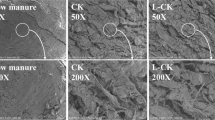Abstract
The potential of Corynebacterium paurometabolum, a Gram positive acid fast bacterium, has been investigated as a biosorbent for the remediation of Cr(VI) and Cr(III). A complete bioremediation of Cr(VI) has been achieved at an equilibrium time of 2 h, initial Cr(VI) concentration of 4 mg/L, pH 1 and a biomass loading of 3.1 × 1010 cells/mL, with equal contributions from biosorption and bioreduction processes, while 55% biosorption has been accomplished at an equilibrium time of 2 h, initial Cr(III) concentration of 4 mg/L, pH 3 and a biomass loading of 3.4 × 1010 cells/mL with respect to the bioremediation of Cr(III). The biosorption isotherms of Cr(VI) and Cr(III) exhibited a typical Langmuirian behaviour. The Gibbs free energies (∆G) have been determined to be −25.5 and −29.5 kJ/mol respectively for Cr(VI) and Cr(III), suggestive of chemisorption. The desorption studies have indicated only a marginal release of Cr(VI)/Cr(III) into the bulk solution, attesting to the irreversible nature of biosorption. FTIR studies have revealed the involvement of hydroxyl, carboxyl, amino and phosphate groups in the biosorption of Cr(VI)/Cr(III). Electrokinetic and X-ray photoelectron spectroscopic studies have provided evidence in support of the biosorption and bioreduction mechanisms of chromium remediation.










Similar content being viewed by others
References
Gad S C, Sci Total Environ 86 (1989) 149.
Das A P, and Mishra S, J Carcinog 9 (2010) 1.
Amiri M J, Fadaei E, Baghvand A, and Ezadkhasty Z, Int J Environ Res 8 (2014) 411.
Levis A G, and Bianchi V, in Biological and Environmental Aspects of Chromium, (ed) Langard S, Elsevier Biomedical Press, New York (1982), p 171.
Barnhart J, J Soil Contam 6 (1997) 561.
Kimbrough D E, Cohen Y, Winer A M, Creelman L and Mabuni C, Crit Rev Environ Sci Technol 29 (1999) 1.
Hawley E L, Deeb R A, Kavanaugh M C, and Jacobs J R G, in Chromium(VI) Handbook, (eds) Guertin J, Avakian C P, and Jacobs J A, CRC Press, Boca Raton (2004), p 273.
Agrawal A, Kumar V, and Pandey B D, Process Extr Metall Rev 27 (2006) 99.
Owlad M, Aroua M K, Daud W A W, and Baroutian S, Water Air Soil Pollut 200 (2009), 59.
Oliveira R C, Palmieri C, and Garcia O, in Progress in Biomass and Bioenergy Production, (ed) Shaukat S S, In Tech, Croatia (2011), p 151.
Sen R, and Chakrabarti S, Curr Sci 97 (2009) 768.
Volesky B, Sorption and biosorption, BV Sorbex Inc, Canada (2003).
Gupta R, Ahuja P, Khan S, Saxena R K, and Mohapatra H, Curr Sci 78 (2000) 967.
Gadd G M, J Chem Technol Biotechnol 84 (2009) 13.
Park D, Yun Y-S, and. Park J M, Biotechnol Bioprocess Eng 15 (2010) 86.
Atkinson B W, Bux F, and Kasan H C, Water SA 24 (1998) 129.
Mohan D, and Pittman C U, J Hazard Mater B137 (2006) 762.
Vijayaraghavan K, and Yun Y-S, Biotechnol Adv 26 (2008) 266.
Sen M, and Dastidar M G, Iran J Environ Health Sci Eng 7 (2010) 182.
Ray S A, and Ray M K, Al Ameen J Med Sci 2 (2009) 57.
Saha B, and Orvig C, Coord Chem Rev 254 (2010) 2959.
Paul M L, Samuel J, Chandrasekaran N, and Mukherjee A, Chem Eng J 187 (2012) 104.
Silva B, Figueiredo H, Quintelas C, Neves I C, and Tavares T, Int Biodeter Biodegr 74 (2012) 116.
Rai D, Eary L E, and Zachara J M, Sci Total Environ 86 (1989) 15.
Ball J W, and Nordstrom D K, J Chem Eng Data 43 (1998) 895.
Kotaś J, and Stasicka Z, Environ Pollut 107 (2000) 263.
Sekhar K C, Subramanian S, Modak J M, and Natarajan K A, Int J Miner Process 53 (1998) 107.
Giles C H, MacEvan T H, Nakhwa S N, and Smith D, J Chem Soc (1960) 3973.
Langmuir I, J Am Chem Soc 40 (1918) 1361.
Socrates G, Infrared and Raman characteristic group frequencies: tables and charts, Wiley, Chichester (2004), p 50.
Jiang W, Saxena A, Song B, Ward B B, Beveridge T J, and Myneni S C B, Langmuir 20 (2004) 11433.
Dambies L, Guimon C, Yiacoumi S, and Guibal E, Colloids Surf A 177 (2001) 203.
Park D, Lim S-R, Yun Y-S, and Park, J M, Chemosphere 70 (2007) 298.
Rai D, Sass B M, and Moore D A, Inorg Chem 26 (1987) 345.
Lederer E, Pure Appl Chem 25 (1971) 135.
Willey J M., Sherwood L M, and Woolverton C J, Prescott, Harley and Klein’s Microbiology, McGraw-Hill Companies Inc., New York (2008), p 57.
Acknowledgements
The authors are grateful to the Institute of Research for Development (IRD), France for sponsoring a research project. DCP thanks the Ministry of Human Resource Development (MHRD), Government of India for grant of a research fellowship.
Author information
Authors and Affiliations
Corresponding author
Electronic supplementary material
Below is the link to the electronic supplementary material.
Rights and permissions
About this article
Cite this article
Prabhakaran, D.C., Subramanian, S. Studies on the Bioremediation of Chromium from Aqueous Solutions Using C. paurometabolum . Trans Indian Inst Met 70, 497–509 (2017). https://doi.org/10.1007/s12666-016-1009-2
Received:
Accepted:
Published:
Issue Date:
DOI: https://doi.org/10.1007/s12666-016-1009-2




